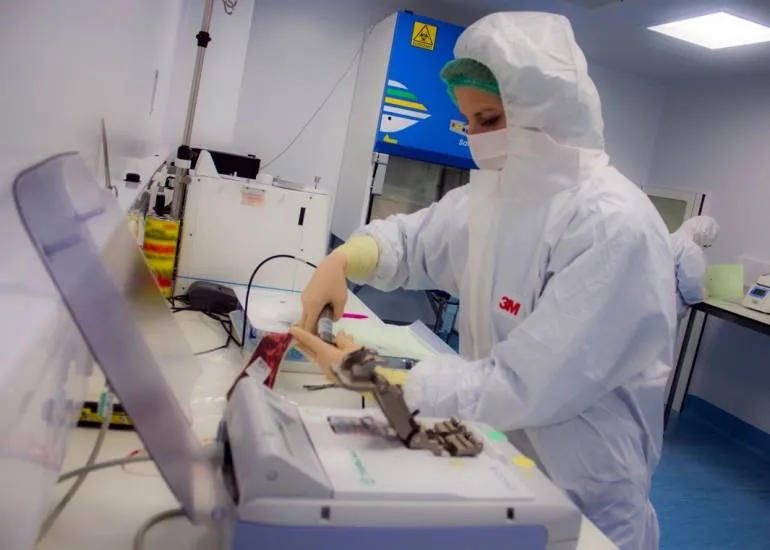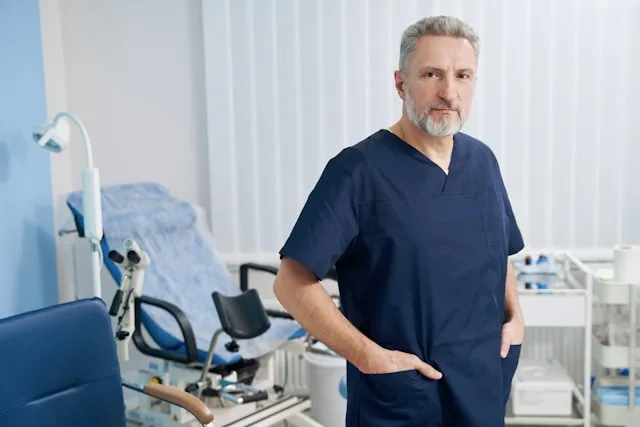Stem cell collection & processing
Stem cell collection
The process is simple, safe, and non-invasive. Immediately after birth, once your baby’s cord has been clamped and cut, a trained specialist collects the remaining blood and tissue from the umbilical cord.
This takes only a few minutes, is completely painless for both mother and baby, and does not interfere with your chosen birth plan. Importantly, the procedure is compatible with delayed cord clamping, so you can still enjoy those first precious moments with your newborn while ensuring their stem cells are preserved for the future.
Your sample is then carefully sealed, documented, and transported under controlled conditions to our laboratory for processing and cryogenic storage.
A healthy future can be planned – it only takes five easy steps
-
1
Order your stem cell collection kit
Order online or by calling 01895 424430. -
2
Inform your phlebotomist
In the UK, a trained and licensed phlebotomist from a dedicated service will perform the collection. -
3
Your kit is collected
Once your baby’s sample has been collected, call Smart Cells. They will send a courier to collect and transport the sample to the laboratory near Heathrow Airport. -
4
Samples are processed
Your baby’s sample is tested, processed, and cryogenically frozen at the laboratory. -
5
Samples are stored for 25 years
Smart Cells will call you to confirm the successful storage of your baby’s sample. This sample will be stored safely for 25 years.
Our Processing Methodology
At Smart Cells, precision and reliability are at the heart of how we prepare every sample. For over two decades, we have perfected a high-efficiency technique called sedimentation with HES (hydroxyethyl starch) — a gold-standard method proven in hundreds of thousands of cord blood collections worldwide.
Step-by-Step: How We Process Your Baby’s Cord Blood
-
1
Careful Separation
Using sedimentation and centrifugation, cord blood is reduced in volume and divided into its main components — plasma, red blood cells, and white blood cells. -
2
Isolating the Buffy Coat
The “buffy coat”, the fraction rich in white blood cells and stem cells, is isolated for long-term preservation. This ensures we retain the most therapeutically valuable portion of your baby’s cord blood. -
3
Secure Cryogenic Preparation
The stem cell-rich sample is placed into a clinical-grade storage bag, sealed in a protective metal cassette, and cooled gradually using a computer-controlled freezing system. Once the sample reaches –160°C, it is transferred into a cryogenic tank, where it is maintained at –196°C in nitrogen vapour. This environment is scientifically proven to preserve stem cell viability for decades.
Rigorous Quality Testing
Every sample goes through a series of strict quality checks to guarantee safety, viability, and clinical readiness:
- Total Nucleated Cell (TNC) count – overall measure of cell content
- CD34+ stem cell count & viability – key indicator of usable stem cells
- Microbiological screening – ensures sterility and safety
- Maternal blood testing – checks for infectious diseases, following regulatory standards
Why This Method Matters
- Higher recovery rates – Sedimentation with HES consistently delivers more viable stem cells than many automated systems.
- Clinically proven – This methodology has been used in transplants at leading medical centres worldwide with outstanding results.
- Trusted by science & families alike – With Smart Cells’ experience and FamiCord’s global network, families benefit from one of the most reliable processing systems available today.

Quality Assurance and Testing
All samples are fully traceable throughout the journey, including testing, receipt, processing, cryopreservation, storage, and release for treatment if required.
Samples are tested and validated for sterility in accredited UK NHS laboratories.
FAQ
- Who collects the samples?
- Can I still have my stem cells collected if I have a home birth?
- Can I wait for the placenta to deliver naturally?
- What is an HLA test and how is it used?
- Do I need to store the cord blood and tissue stem cells in the country I intend to use it?
- Why do Smart Cells volume reduce process cord blood before storage?
- Does my hospital allow me to have stem cells collected?
- Does it matter if the birth is caesarean section or natural delivery?
- Does cord blood and tissue collection hurt?




